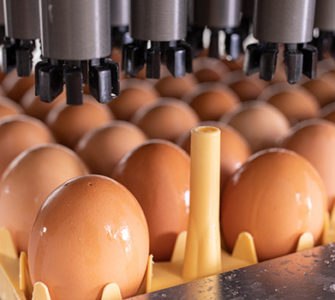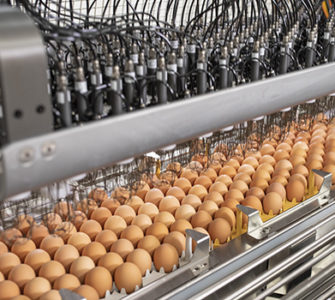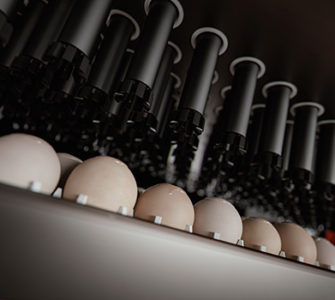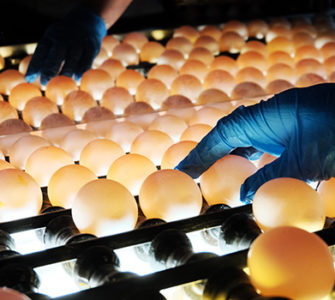‘Location, location, location’ keys to successful in ovo vaccination
By Tarsicio Villalobos, DVM
Director, Technical Service
Zoetis Inc.
In ovo vaccination is now common in most large US hatcheries and the practice is also catching on quickly in Latin America and Asia. Not surprisingly, more in ovo vaccination devices have entered the market.
At first glance, in ovo vaccination equipment appears to be complex – and indeed it incorporates a wide range of very innovative bioengineering design features that make comparisons difficult.
However, when choosing the most appropriate equipment, there is one simple function that is of paramount importance: consistent delivery of vaccine to the correct site within the egg. Above all others, this single feature dictates the success or failure of in ovo vaccination.
Myth busting
Late last year when I attended the XXIII Latin American Poultry Association Congress in El Salvador, I was impressed by the level of interest in all things in ovo. However, I was concerned by the number of people who seemed to think that it didn’t matter where you delivered an in ovo vaccine, as long as it landed in the egg. Research conducted over the last few years confirms that proper site of injection is imperative for effective in ovo vaccination.
In a US study, investigators compared two different in ovo devices under field conditions and the rate of hatch was significantly different (p≤0.05) with one of two devices.[1]
The study included both whole hatchery and paired testing. In the whole hatchery comparison, the throughput of two hatcher hallways in a commercial hatchery was alternately processed by the two devices. Each day, approximately 230,000 eggs were vaccinated with one of the two devices at 19 days and 1 hour of incubation; overall, about 7 million eggs were injected during the 9-week trial.
For the paired testing part of the study, eggs were randomized to one device or the other during the transfer from incubation flats to hatching baskets; over 29,000 eggs were injected with each treatment at both days 18 and 19 of incubation.
The whole-hatchery comparison demonstrated that the hatch rate was higher with the double-needle, System A device compared to the single-needle, System B device (Table 1).
Table 1: Percent hatch for whole hatchery trials
| Day of in ovo injection | System A | System B |
| 18 | 82.84% | 80.63% |
| 19 | 83.45% | 83.06% |
| Total | 83.16% | 81.91% |
Paired testing revealed a statistically significant advantage (p≤0.05) for System A at day 18, but there was no significant difference between systems for injections administered on day 19 (Table 2).
Figure 2. Percent hatch for paired trials — embryos alive at injection on transfer
| Day of in ovo injection | System A | System B |
| 18 | 96.01% (p≤0.05) | 94.46% |
| 19 | 97.50% | 97.09% |
| 18/19 | 96.75% (p≤0.05) | 95.76% |
Economic impact
To put these results into an economic context, a difference of just 1% in the rate of hatch was equivalent to around US$5,000 per week in the particular hatchery at the time this study was conducted. This difference between the two devices could have an impact of US $260,000 each year.
This study showed that hatchability could vary significantly from one in ovo vaccination device to another. The next question is why.
When the first commercial in ovo device was developed more than 20 years ago, it was known that timing and site of injection were critical success factors in the efficacy of Marek’s disease vaccination.
Studies had shown that the in ovo vaccine needs to be delivered between 17 days 12 hours and 19 days 4 hours of incubation. This is when the embryo is in position to hatch with its head under the right wing, and the stalk of the yolk sac entering the abdomen. The vaccine must be delivered into the amniotic sac or into the embryo itself — intramuscularly (IM) or subcutaneously (SC) — for optimal effect.
As a result of this understanding, the first device was designed specifically to deliver vaccine into the correct site, time after time. So perhaps the difference in hatchability between devices in the above study was related to the consistency of vaccine delivery; perhaps occasional, inaccurate injections were injuring embryos and adversely affecting hatchability
Accuracy study
Another US study was conducted in two commercial broiler hatcheries to discover whether the accuracy of vaccine delivery did, in fact, vary between the same in ovo devices that had been used in the previous study.
A standard Marek’s vaccine was mixed with a protein-staining dye so that the site of injection within the egg could be determined. Delivery of the vaccine into the amniotic sac by IM or SC injection of the embryo were considered correct; delivery into the air cell, allantoic sac, or embryo abdomen, cranium, thoracic cavity, etc. was considered incorrect. Each device was used to process over 1,000 normal eggs, with one hatchery using Chick Master and the other Jamesway Super J.
The results of this study revealed a major difference in the accuracy of the two devices: System A delivered vaccine correctly in nearly 95% of eggs in one hatchery and in over 91% in the other hatchery. System B was correct just 61.16% and 71.98%, respectively (Table 3).[2]
Table 3. Percentage of eggs with correct vaccine delivery (n=no. eggs injected)
|
System |
Chick Master hatchery | Jamesway hatchery |
|
System A |
94.62% (n=1,108) |
91.04% (n=843) |
|
System B |
61.16% (n=696) |
71.98% (n=255) |
| Statistical significance | (p≤0.05) |
(p≤0.05) |
This was a clear demonstration that accuracy of vaccine delivery could vary considerably between devices. This also might explain the difference in hatchability between devices, because one may be injuring and thus reducing the viability of more embryos.
System A utilizes compressed air that causes a tubing matrix to expand and firmly hold the floating injectors. This facilitates positioning of the injection tools directly above the apex of the individual egg, irrespective of its size, shape or orientation.
Hatchability is, of course, an important parameter for hatcheries, and it is essential for any in ovo device to maintain hatchability at as high a level as possible. However, the main reason for using an in ovo vaccine is to enhance bird performance post-hatch, by helping protect against disease challenge.
Disease protection study
A third US study was therefore designed to compare hatchability and protection against Marek’s disease using the same two injection devices.
Broiler eggs were vaccinated at day 18 with a herpesvirus of turkey vaccine (HVT) commonly used in the broiler industry to protect against Marek’s disease virus (MDV) and a recombinant vaccine that uses the same HVT with an insert of Gumboro Diseases viral protein (rHVT-IBD). Either System A, the double-needle device, was used or System B, the single-needle device. Birds were challenged at 5 days of age with the very virulent RBIB strain of MDV and weighed on days 14, 21 and 49. Necropsy was performed at day 50 to check for Marek’s lesions or before if birds died early.
The results showed that the percent hatch and bodyweight varied between devices, with the double-needle device producing better results. There was also a marked difference in the percentage of birds developing Marek’s disease, with the double-needle device again producing superior results (Figure 1).[3]
Consequences of inaccurate delivery
It is clear from these studies that different in ovo devices will produce different results for hatchability and subsequent bird performance.
Delivering a vaccine into the wrong site in the egg has two potentially adverse consequences. First, there is a reduction in hatchability since some embryos die, probably as a result of injuries caused by the needle — for example, if the cranium is hit. Second, there is suboptimal protection against disease challenge.

Figure 2. Eggs must be aligned correctly and individually to achieve a high rate of accurate injections.
Birds that do not develop a good immune response because a vaccine is delivered to the wrong site can go on to become susceptible to field virus and serve as high-virus shedders in the flock. If there are enough of them, then even well-vaccinated birds can be overwhelmed by a high challenge and develop disease.
Both of these consequences have been demonstrated in commercial trials and both have the potential to significantly affect production efficiency and economics. It is therefore essential to keep the number of inaccurately vaccinated birds to a minimum by choosing an in ovo device that injects into the correct site as consistently as possible (Figure 2). Just because an egg is injected doesn’t mean that its embryo is immunized.
The ability to deliver vaccine into the optimal site varies from device to device depending on the level of bioengineering excellence incorporated within its design. Hatchery managers need to be aware that not all in ovo devices are created equal, and they need to ask the right questions before making any equipment purchasing decisions.
Article courtesy of International Hatchery Practice
References
[1]Williams CJ and Zedek AS. Comparative field evaluations of in ovo applied technology. Poultry Science 2010; 89: 189-193.
[2]Williams CJ and Hopkins BA. Field evaluation of the accuracy of vaccine deposition by two different commercially available in ovo injection systems Poultry Science 2011; 90: 223-226.
[3]Barbosa T, et al. Comparison of hatchability performance and protection against Marek’s disease in broilers vaccinated with two in ovo vaccination systems and two HVT vaccines. Presented at AAAP meeting, July 2013, Chicago. [Study report no. 03-12-70R7B]
Posted on March 3, 2015


















